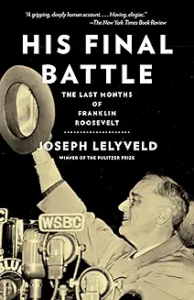His Final Battle: The Last Months of Franklin Roosevelt by Joseph Lelyveld 2016
When 1944 dawned, Roosevelt was facing a number of major questions, any one of which would have been daunting for a less accomplished and experienced politician and visionary. WWII in both Europe and Japan was raging and with D-Day still six months away and with the landing site, the commander, and the timing not yet agreed upon with Churchill and Stalin and with Hiroshima and Nagaski and Japan’s surrender even further in the future, it was not yet clear that the Allies would emerge victorious. At the same time, Roosevelt was looking ahead to a post-WWII international body that would ensure peace going forward. Having experienced Woodrow Wilson’s failure to deliver on the League of Nations dream, he was determined to create a body that would be effective in continuing the alliance between Stalin’s Russia and Churchill’s Great Britain despite the former’s designs on Eastern Europe, especially Poland, and the latter’s commitment to maintaining Britain’s colonial empire.
In the midst of all of this, Roosevelt was facing uncertainty about his own political future. Would he run for an unprecedented fourth term? Would he stick with Henry Wallace for his VP or turn to yet another? Would he be able to count on the Democratic majority in Congress imperiled by the growing pressure for civil rights and the end of segregation in the South? And in the background and occasionally dominating the action, was his deteriorating health. Weight loss, an ashen complexion, extreme fatigue, occasional periods of chest pain and disorientation all combined to cause concern among his closest family members and his staff about his ability to finish this work even if elected to that fourth term.
Lelyveld, a long time writer and editor at the New York Times and a Pulitzer Prize winner for his book about South Africa, skillfully walks us through this three dimensional chess game as 1944 unfolds—summit conferences with Churchill and Stalin at Teheran and later at Yalta, the last minute decisions to run for that fourth term and to choose the Senator from Missouri, Harry S. Truman as his new VP running mate, winning an election in which he only campaigned during the last three weeks, getting his way for Eisenhower to command the D-Day landing in France, increasingly failing to get Stalin to concede on Poland and the post-war United Nations plan, and again and again, his failing health.
I was repeatedly struck by the incredible differences between the world of 1944 and today. The summits in Teheran and Yalta involved travel by boat, train, and car that took weeks and kept the president away from D.C. and domestic issues. The press and therefore the public were excluded from reporting on major events, the details of FDR’s deteriorating health, and the multiple relationships with women who were central to FDR’s need for companionship and adoration. FDR spent long periods away from the White House either at Hyde Park or in Warm Springs, Georgia and provided with the need for security during war-time, reporters and the public had little knowledge of where he was or what he was doing. The Manhattan Project was able to consume huge amounts of taxpayer money without any oversight by Congress. And at the very foundation of all of this was a four term president who relied almost entirely on his instincts and his desire to keep his options open as long as possible. For example, Cordell Hull, the long-serving Secretary of State wasn’t even present at Yalta and Roosevelt conducted foreign policy largely independent of State.
These arrangements, however strange from today’s perspective, were largely successful. The U.S. triumphed in Europe and Japan. The United Nations was launched successfully. The GI Bill transformed post-WWII America into a land of opportunity and middle class stability. On the other hand, FDR’s hopes for a partner in Stalin and Russia were futile, and nuclear weapons proliferated. Seeds of eternal conflict were sown in the Middle East, and the U.N has proven to be less than successful in keeping the peace. Tragically, Roosevelt did not live to see the results of his tireless work. He died in Warm Springs on April 11, 1945 just six weeks into his fourth term, the victim of malignant hypertension, congestive heart failure, and a hemorrhagic stroke. He was only 63.
For any student of the presidency, FDR, or WWII, this is an essential book. Lelyveld writes clearly and provides a sense of novelistic suspense as he tells this gripping tale of a world at war and a remarkable man who led the world through those years.



